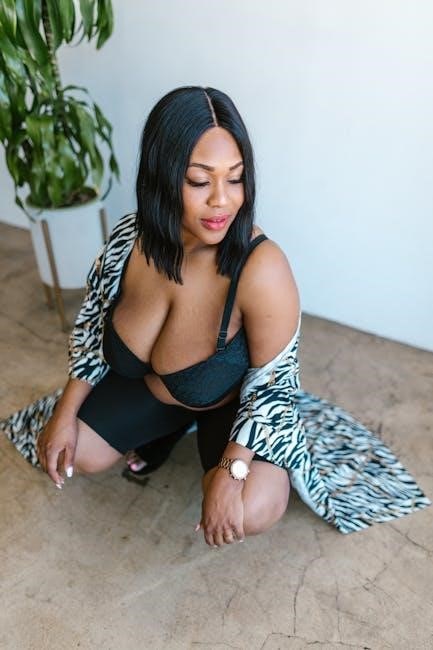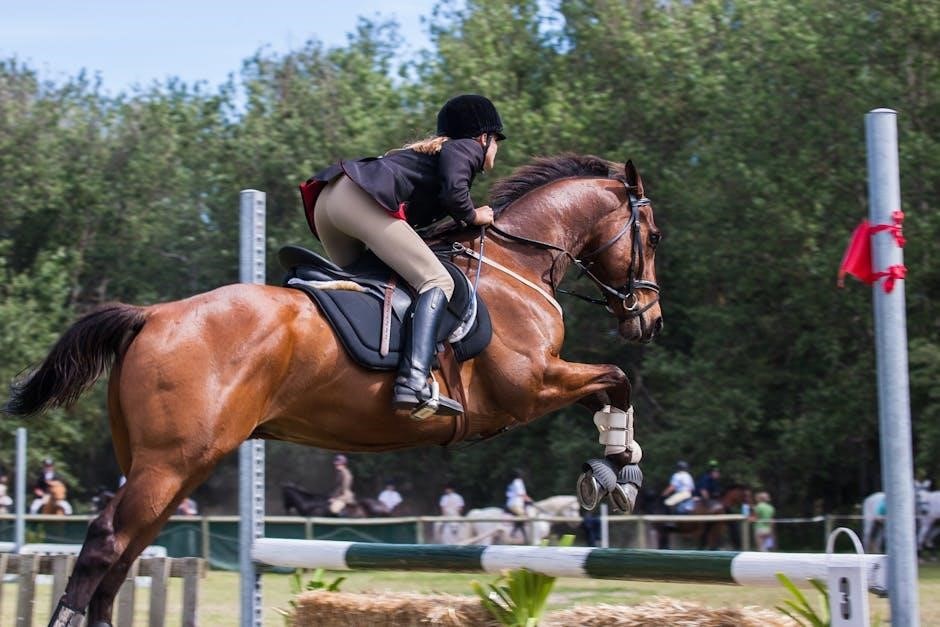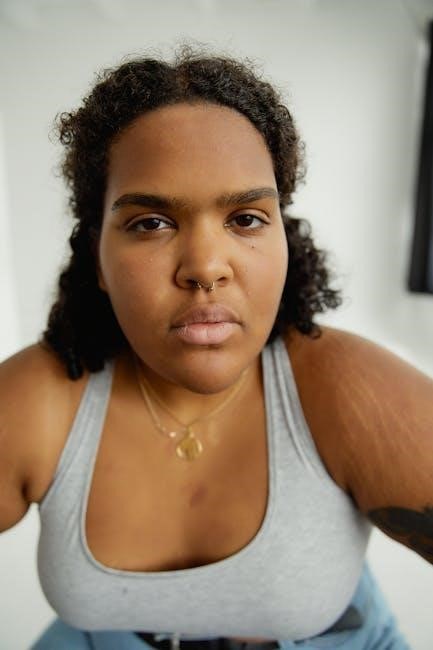Finding the right Jockey bra size is essential for comfort and support․ A well-fitting bra enhances your silhouette and prevents discomfort․ This guide will help you navigate Jockey’s sizing system and find your perfect fit․

Understanding Band Size Measurement
Your band size provides foundational support․ It should fit snugly around your ribcage․ Measure directly under your bust with a soft measuring tape․ Ensure the tape is level for an accurate measurement to determine band size․
How to Measure Your Underbust
To accurately determine your Jockey bra band size, start by wearing a non-padded bra or going bra-less for the most precise measurement․ Stand in front of a mirror to ensure the measuring tape is level around your torso․
Wrap the measuring tape directly under your bust, where your bra band typically sits․ The tape should be snug but not too tight, allowing you to breathe comfortably․ Exhale completely and take the measurement in inches or centimeters, depending on the Jockey size chart you are using․
If your measurement is a whole number, that’s your underbust size․ If it’s a fraction, round up to the nearest whole number․ This number is the foundation for determining your bra band size according to Jockey’s specific sizing guidelines․
Record this number, as you’ll use it later to match with the Jockey size chart for finding your corresponding band size․ Remember to keep the tape level for precise results!
Determining Cup Size
Finding your correct cup size is crucial for bra fit․ It involves measuring around the fullest part of your bust and calculating the difference between that and your underbust measurement to determine cup size․
Calculating Cup Size Based on Bust Measurement
To accurately calculate your Jockey bra cup size, begin by measuring around the fullest part of your bust, ensuring the measuring tape is level and snug but not too tight․ Subtract your underbust measurement from this bust measurement․ The difference determines your cup size․
A difference of 1 inch typically corresponds to an A cup, 2 inches to a B cup, 3 inches to a C cup, and so on․ For example, if your bust measurement is 35 inches and your underbust is 32 inches, the difference is 3 inches, indicating a C cup․
Remember, this is a starting point․ Always refer to Jockey’s specific bra size chart for the most accurate conversion․ Cup sizes can vary slightly between brands, so consulting the chart is crucial for finding the perfect fit within the Jockey range․
If the cup feels too tight, breasts bulge from the top or sides, consider increasing your cup size for a perfect fit․ Conversely, if the cup is loose, with a gap or wrinkling, decreasing your cup size for the right fit․

Jockey’s Bra Size Chart: A Detailed Look
Jockey International provides a comprehensive size guide to help you find the perfect fit for their bras․ Understanding the bra size chart is crucial for selecting the right size and ensuring optimal comfort and support․ The chart typically includes band sizes, ranging from 32 to 44, and cup sizes, from A to E and beyond, in some styles․
To use the chart effectively, first measure your underbust to determine your band size․ Then, measure your bust to calculate your cup size, as detailed in the previous section․ Once you have both measurements, locate the corresponding size on the Jockey bra size chart․
Jockey’s Forever Fit bras also offer extra flexibility in sizing․ If you’re in between sizes, consider how your bra cups currently fit․ If they’re full, go up; if there’s gaping, go down․ Remember to consult Jockey’s official website or product pages for the most accurate and up-to-date size chart information, as variations may exist between different bra styles and collections․
Sister Sizes Explained
Sister sizes are alternative bra sizes with equivalent cup volume․ If your band feels too tight or loose, trying a sister size might provide a better fit while maintaining the same cup volume․
How to Find Your Sister Size in Jockey Bras
Finding your sister size in Jockey bras is a simple adjustment to band and cup․ If your current Jockey bra band feels too snug, go up one band size and down one cup size․ For example, if you wear a 34B and the band is tight, try a 36A․
Conversely, if the band is too loose, decrease the band size and increase the cup size․ So, a 34B that’s loose becomes a 32C․ Remember, the goal is to maintain similar cup volume while improving band fit․
Jockey bras offer flexibility, so consider cup fit․ If cups are full, go up; if gaping, go down․ Always prioritize comfort and support․ Use Jockey’s size charts as a guide․ Stop in any Jockey outlet store for a fitting․
Factors Affecting Bra Size
Several factors influence bra size․ Weight fluctuations, pregnancy, and hormonal changes all impact breast tissue․ Regular bra size checks, especially after significant body changes, are crucial for maintaining optimal fit and support․
Weight Changes and Pregnancy
Weight fluctuations and pregnancy significantly impact bra size․ Weight gain often increases breast size, necessitating a larger cup and potentially a wider band․ Conversely, weight loss can decrease breast volume, requiring a smaller cup size․ Pregnancy causes hormonal shifts that lead to breast enlargement, particularly in the early stages․ It’s common to go up several cup sizes during pregnancy and breastfeeding․
Regular measurements are vital during these times to ensure proper support and comfort․ Ill-fitting bras can cause discomfort, back pain, and skin irritation․ Investing in new bras that accommodate your changing body is crucial for maintaining breast health and overall well-being․ Consider consulting a professional bra fitter for personalized advice during pregnancy and postpartum․
Remember that breast size may fluctuate even after pregnancy as your body adjusts․ Be patient and continue to monitor your fit regularly․

Common Bra Fitting Issues and Solutions
Many experience bra fit problems․ This section addresses gaping cups, tight bands, and slipping straps․ Identifying the issue is key to finding the right solution for a comfortable and supportive fit with your Jockey bra․
Gaping Cups, Tight Bands, and Slipping Straps
Gaping Cups: If there’s space between your breasts and the cup, consider decreasing your cup size․ Alternatively, try a different bra style․ It’s essential that the cup snugs the breast, covering the front and sides without bulging․ If bulging occurs, increase your cup size․ A loose cup will wrinkle․
Tight Bands: A snug band is ideal, forming a level line around your torso․ If it digs or causes bulging, loosen the hook․ If that fails, increase the band size and decrease the cup size (e․g․, from 34B to 36A)․ A too-tight band causes discomfort and marks on the skin․
Slipping Straps: Straps should sit comfortably without digging in or falling off․ Tighten slipping straps․ If that doesn’t work, consider multiway styling bras․ Straps digging into your skin mean they’re too tight; loosen them․ If issues persist, increasing the band size is necessary․
Jockey Bra Styles and Fit Considerations
Jockey offers a diverse range of bra styles, each designed with unique fit considerations․ The Jockey Back Smoothing Seamfree Bralette prioritizes comfort with soft, wire-free molded cups and extra back smoothing․ Consider the level of support and coverage you desire when selecting a style․ For everyday wear, T-shirt bras offer a smooth, invisible look under clothing․
Sports bras provide enhanced support during physical activity․ Nursing bras cater to the needs of new mothers with convenient access for breastfeeding․ Strapless bras offer versatility for various outfits․ When choosing, remember that cup and band size remain crucial, but style-specific features like strap placement and closure types can influence overall fit and comfort․ Always refer to the size chart and consider trying different styles to find your perfect match․

Maintaining Your Bras for Lasting Fit
Proper care extends the life and maintains the fit of your Jockey bras․ Hand-washing is recommended to preserve elasticity and shape․ If using a machine, place bras in a lingerie bag on a delicate cycle․ Avoid harsh detergents and bleach, which can damage fabrics and elastics․ Always air dry bras; high heat from dryers can warp underwires and compromise the fit․
Store bras properly to prevent distortion․ Avoid folding molded cups inside out, as this can cause creases․ Instead, stack bras neatly in a drawer or hang them by their straps․ Rotate your bras regularly to prevent over-wearing and allow elastics to recover․ With proper care, your Jockey bras will provide lasting support and comfort․
